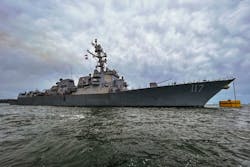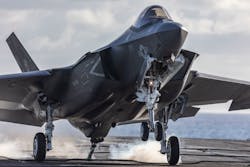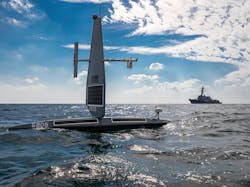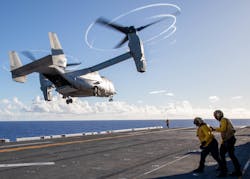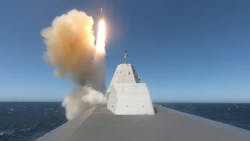Congress backs Navy push for more ships, combat power
By Edward J. Walsh
NASHUA, N.H. - U.S. Navy leaders say their top priorities are building more ships, fighting well in contested seas, extending battle ranges, increasing deception, and enhanced information warfare.
The Navy’s priorities for shipbuilding and weapon systems in 2023 and beyond are spelled out in Chief of Naval Operations Adm. Michael Gilday’s CNO Navigation Plan, released in July 2022. The plan unveils the CNO’s six force design imperatives that seek to maintain combat credibility in increasingly contested seas; expand distance; leverage deception; harden defense; increase distribution; ensure delivery, and generate decision advantage.
Gilday says the imperatives enable distributed maritime operations, the Navy's foundational operating concept. Still, he argues that the fleet needs more ships.
U.S. and allied naval analysts point out that increasingly contested seas refers primarily to China’s navy. An International Institute for Strategic Studies (IISS) report called Military Balance 2022, points out that “China’s shipbuilding output remains prodigious.”
IISS notes that the Chinese navy has strengthened its near-seas capability with commissioning of 72 1,500-ton Type-056/056A corvettes since 2012, adding that “the commissioning of the first 40,000-ton Type-075 large helicopter-capable amphibious assault ship, continued aircraft-carrier development, and the commissioning of a growing number of frigates and destroyers reflect determined efforts to develop a blue-water navy.”
Last April, the IISS study reports, the Chinese navy commissioned its third 11,000-ton Type-055 guided-missile cruiser and a Type-094 nuclear-powered ballistic-missile submarine.
The Navy also is watching Russian naval activity. Despite Russia’s grinding land war with Ukraine and loss of several ships, national security analyst Daniel Flott of the Defense and Statecraft Program of the Centre for Diplomacy, Security, and Strategy writes that “Russia still enjoys naval dominance in the Black Sea. The West should consider how to hold Russian naval targets at risk.”
The Navy faces increased tensions in Middle East waters. In April 2022 Navy Fifth Fleet Commander Vice Admiral Brad Cooper announced the standup of a task force of the 34-nation Combined Task Force, which Cooper also commands, to respond to drone attacks and arms smuggling in waters around Yemen and by Iran. The force of as many as eight ships also would target human and drug trafficking in the region
Force planning
Due to continuing funding pressures and new capabilities offered by unmanned systems, the Navy has moved past its Force Structure Assessment of December 2016 that called for a total force of 355 manned ships. A new so-called distributed fleet architecture still being developed would have three tiers: (1) fewer cruisers, destroyers, and large amphibious-assault ships; (2) more small combatants like frigates, large patrol craft, small amphibious attack ships, and logistics ships; and (3) small corvettes, manned and unmanned patrol craft, and large unmanned surface and undersea vehicles (USVs and UUVs).
The 2023 defense authorization act approved by Congress in December provides $32.6 billion for construction of 11 ships, which is up from the Navy’s request for eight: two Virginia-class attack submarines, three Arleigh Burke-class destroyers, two expeditionary fast transport ships, one Constellation-class frigate, one San Antonio-class amphibious-assault ship, one fleet replenishment oiler, and one towing and salvage ship.
The authorization calls for multiyear contract buys of 25 ship-to-shore connectors, 15 Burkes, eight oilers, and five amphibious ships. The bill forbids the Navy from retiring 24 ships, including five of the nine littoral combat ships that Navy leaders hoped to remove from the fleet.
The 30-year shipbuilding plan lays out three potential force levels, called Alternatives 1, 2, and 3. All three project 300 ships by 2035. The first alternative aims at 316 by 2052; the second and third would get the Navy to 327 and 367, respectively, by 2052.
Yet as in past years, the Navy faces mismatched funding levels and strategic priorities. In Senate Armed Forces Committee testimony last May, Gilday said theCompeting analyses have produced different numbers. A 2019 Navy Integrated Naval Force Structure Assessment, according to the Congressional Research Service and press reports, arrived at 390 manned ships and 45 unmanned vessels. A U.S. Department of Defense (DOD) Future Naval Force Study was reported to call for as many as 530 ships.
Shipbuilding
Throughout 2022 the Navy’s shipbuilders delivered new ships and moved forward on others. Huntington Ingalls Industries and General Dynamics Bath Iron Works have switched from Flight IIA Arleigh Burke-class (DDG 51) destroyers to the extensively redesigned and more heavily armed Flight III variant.
Huntington Ingalls is well along in construction of Flight III ships at its Pascagoula, Miss., shipyard: Ted Stevens (DDG 128), Jeremiah Denton (DDG 129), George M. Neal (DDG 131), and Sam Nunn (DDG 133). The first Huntington Flight III hull, Jack H. Lucas (DDG 125), completed builder’s sea trials in December. Bath is working on Flight III hulls Louis H. Wilson Jr., (DDG 126), William Charette (DDG 130), and Quentin Walsh (DDG 132).
The Navy already is looking beyond the Burkes. In mid-2021 the Program Executive Office/Ships established a DDG(X) program office to study the next large surface combatant. The PEO said that the Navy hoped to fund the first DDG(X) in 2028.
In July 2022 Huntington Ingalls and Bath received one-year contracts for design analysis for a DDG(X) with options that could extend the work out to 2028.
The littoral combat ship program, which has experienced cost overruns and maintenance problems for years, is split between a Lockheed Martin Corp. and Fincantieri Marinette Marine team, which builds the Freedom variant ships with a conventional single hull and General Dynamics and Austal USA, which build the Independence ships with a trimaran hull.
Ten Freedom-type ships and 14 Independence ships have been delivered. Six more Freedom hulls and five Independence ships are under construction or in pre-production.
Due to concerns about littoral combat ship survivability, in April 2020 the Navy awarded Fincantieri a design and construction contract for the Constellation-class frigates. The new frigates will be 496 feet long, with full-load displacement of 7,290 tons, with a maximum speed of 26 knots. The Constellation design is derived from the company’s FREMM design used also by the French and Italian navies. The Navy plans to build 20 Constellation-class ships.
Last August the company started work on Constellation at its Marinette, Wis., shipyard. The Navy has exercised options for Congress and Chesapeake (FFGs 63 and 64); Finacantieri has options for seven more. Constellation is scheduled to enter service in 2026. In June Lockheed Martin won a $10.5 million award for integration and testing of the Constellation-class combat system.
In July the Navy commissioned the San Antonio-class amphibious transport dock Fort Lauderdale (LPD 28), twelfth ship of the class. Huntington Ingalls is buildingThe Navy originally planned to build 13 Flight II San Antonios. Instead, the 2023 budget proposes ending Flight II production with one more ship, for a total class of 13 Flight I and three Flight II hulls. The Navy says it will begin studying a new LPDX class this year.
In October the Navy awarded Huntington Ingalls a contract for detail design and construction of Fallujah (LHA 9), the fourth America-class big-deck amphib. America and Tripoli (LHAs 6 and 7) are in the fleet and Bougainville (LHA 8) is under construction. The company started fabrication for Fallujah in late December.
The America-class ships are built with a combined gas turbine and diesel-electric propulsion system. The gas turbines are used for high speeds, maximizing their fuel efficiency, and the diesel-electric motors for lower speeds. The America-class initially were designed as aviation platforms without welldecks for deploying landing craft. Because of Marine Corps concerns the Navy modified the design for Bougainville and Fallujah to add welldecks.
The 2016 force assessment assumed 38 amphibious ships. Navy Secretary Carlos Del Toro has said he wants 31 amphibs. Marine Corps Commandant Gen. David Berger also pushed for 35 light amphibious warships that he says would present smaller targets. The Navy has said it expects to start buying light amphibious warships in 2025.
The last of three nearly 16,000-ton Zumwalt-class destroyers built by Bath Iron Works -- Lyndon B. Johnson (DDG 1002) -- is going through combat systems testing. The first two ships, Zumwalt (DDG 1000) and Michael Monsoor (DDG 1001) are in the fleet. The three-ship class brings the Navy close to a true electric-drive integrated power system, a longtime Navy goal. The Navy chose an induction motor provided by General Electric’s Power Conversion unit instead of more revolutionary permanent magnet motors that once were considered.
The ships originally were planned for naval surface fire support but have been shifted to the surface warfare mission because the Navy canceled the long-range land-attack projectile that was being built for the Zumwalts’ advanced gun system, which will be removed from the ships this year.
The Navy’s highest acquisition priority continues to be the 12-boat Columbia-class ballistic missile submarine (SSBN) program that will replace the in-service Ohio class as the sea-based component of the nation’s strategic-weapons triad. The Columbias will be 560 feet long and displace 21,000 tons, and powered by a “life-of-ship” nuclear fuel core that will eliminate the need for a mid-life refueling.
The Navy awarded the District of Columbia (SSBN 826) contract to General Dynamics Electric Boat in November 2020. Electric Boat is teamed with HuntingtonElectric Boat laid the keel for the ship in June last year. The second ship will be Wisconsin (SSBN 827). The 14-boat Ohio class will start retiring in 2027, when District of Columbia is scheduled for delivery. Electric Boat says the ship will be ready for its first patrol in 2031. Starting in 2031 the Navy will replace the Ohios one-for-one with the new Columbia-class ships.
Electronic sensors
The Navy’s most visible surface warfare system in 2022 was the SPY-6(v) long-range radar built by the Raytheon Technologies Corp. Missile and Defense unit. The SPY-6(v) will become the baseline radar for nearly all front-line surface combatants, carriers, and amphibious ships.
Raytheon won the SPY-6(v) contract in 2013, ousting Lockheed Martin, longtime builder of the SPY-1(v), the primary air-defense radar for Ticonderoga-class cruisers and Burke destroyers. Lockheed Martin will continue to provide the Aegis combat system for the Flight III Burkes.
Raytheon says the SPY-6(v) transmit-receive modules use monolithic microwave integrated circuits (MMICs) fabricated with gallium nitride that allow order-of-magnitude increases in processing speed and substantial size reduction in an open processing architecture.
The SPY-6(v)1 has been installed on Jack H. Lucas. Raytheon has delivered radar arrays to Huntington Ingalls for Ted Stevens and to Bath Iron Works for Louis H. Wilson Jr.
America-class amphibs and Nimitz-class aircraft carriers will get the SPY-6(v)2. New Ford-class flattops and Constellation-class frigates will get a three-array (v)3 system, called the Enterprise Air Surveillance Radar. Last July Raytheon delivered the first (v)3 radar arrays to Huntington Ingalls for John F. Kennedy (CVN 79), the second of four Ford-class CVNs. In-service Flight IIA Burkes will receive a (v)4 variant.
Raytheon designed the SPY-6(v) using a digital engineering process at the company’s Immersive Design Center in Andover, Mass. Company officials says the IDC uses artificial intelligence and machine learning and a 32-foot-long light-emitting diode screen that provides a three-dimensional environment for the design work.
The Navy is pursuing digital engineering for combat system development at its Forge software factory in Riverdale, Md. Sigma Defense Systems LLC in Perry, Ga., says it’s supporting the Forge by providing teams to develop an integrated combat system that consists of “loosely coupled, modular, low cost, and scalable software components” for surface combatants, aircraft carriers, and amphibious ships, outside the traditional acquisition process.
Lasers and weapons
In August 2022 Lockheed Martin delivered a high-energy laser with integrated optical dazzler and surveillance unit (HELIOS) for testing aboard the destroyer USS Preble (DDG 88). The HELIOS, a 60-plus kilowatt laser, is designated Increment 1 of the Surface Navy Laser Weapon System (SNLWS) program.
Company officials say the HELIOS is an “endless magazine that never runs out of bullets.” The laser draws its energy continuously from the ship’s power system. The HELIOS is able to destroy surface and airborne threats and “dazzle” or blind optical sensors aboard hostile ships and aircraft, and optical seekers of anti-ship missiles.
The company says the HELIOS already is integrated with the Aegis combat system. The system is targeted at in-service Flight IIA Burkes but not the Flight IIIs because the power generation capability of the Flight IIIs is heavily dedicated to the SPY-6(v). Adding HELIOS would require taking something else off.
In June the Missile Defense Agency awarded Raytheon an $867 million contract for SM-3 Block IIA missiles that will go aboard Burke DDGs and Japan’s Aegis destroyers. The SM-3, fitted with a kinetic interceptor rather than an explosive warhead, is capable of destroying short and intermediate-range ballistic missiles. Navy officials say the SM-3 Block IIA is a component of the Phased Adaptive Approach for missile defense in Europe, and is now operational at MDA’s Aegis Ashore site in Romania.
Raytheon won a November award for the air-defense rolling airframe missile (RAM) for the Navy and for the German navy. The company continues to build the Evolved Seasparrow Block 2, Mk 15 close-in weapon system, and Standard missile Block III.
Raytheon also won contracts for full-rate production for the Block V Tomahawk all-up round and the over-the-horizon weapon system or OTH-WS, which launches a Naval strike missile and is planned for the littoral combat ships.
The Navy is upgrading the Cooperative Engagement Capability (CEC), a shipboard, airborne, and shore-based system that creates an integrated targeting network. In September Raytheon, longtime systems integrator for CEC, received $77 million in new options for CEC engineering support, including work for Japan, Australia, and Canada, and a $27 million award in July for the CEC planar array assembly for the U.S. and Canadian navies.
In September L3Harris Technologies in Melbourne, Fla., won a $32 million contract for CEC spares and signal data processors, and an October CEC award for $40.9 million.
Raytheon received an Office of Naval Research contract last April to study flexible digital beamforming and other radar functions under the Agnostic Signal Processing for Increased Radar Efficiency (ASPIRE) research initiative, a two-year effort to develop new radar signal generation capabilities and improve radar signal-processing designs, and reduce weight and power requirements for Navy radars.
The Navy’s Conventional Prompt Strike initiative is collaborating with the Army’s Long Range Hypersonic weapon program to develop sea- and land-based hypersonic missiles. DOD accelerated hypersonic missile research following China’s launch of a hypersonic weapon in October 2021. Hypersonic weapons will travel at Mach 5, more than 4,000 mph. Both the Navy and Army programs will use a hypersonic glide body.
In late October the services launched a rocket at the NASA Wallops Island, Va., test facility containing 11 experiments to gather data on advanced electronics components needed for hypersonic weapons. In mid-November Raytheon and Northrop Grumman both received additional MDA funding for work on Glide Phase Interceptor concepts through July of this year.
The Navy is upgrading ship navigation. In October the Navy’s Operational Test and Evaluation Force ruled Northrop Grumman’s shipboard electronic chart display and information system (ECDIS) operational suitable for surface ships. The system will go aboard 115 ships—carriers, surface combatants, and amphibs. The company separately won awards for production of ECDIS software and its integrated bridge systems for Burke destroyers.
Unmanned systems
A Navy Unmanned Campaign Framework, released in March 2021 announced that the Navy was “aligning our unmanned systems to executive Distributed Maritime Operations … tightly coupling our requirements, resources and acquisition policies.”
L3Harris, teamed with Swiftships Inc. in Morgan City, La., is working on a $35 million Navy contract for a prototype medium unmanned surface vehicle (MUSV). The contract includes options for eight vehicles. In July the Navy awarded Leidos Inc. an $11.9 million contract for an MUSV design.
The Navy’s vision includes larger USVs and large and extra-large UUVs. In September 2020 the Navy awarded contracts for studies of LUSV designs to Huntington Ingalls, Lockheed Martin, Bollinger Shipyards, Fincantieri Marinette Marine, Gibbs & Cox, and Austal USA. The studies have been completed.
In early 2019 the Navy tapped a Boeing and Huntington Ingalls team for the extra-large (XLUUV) program, including construction of five vehicles called Orcas. Last September Boeing won an $11.6 million award for engineering support for the XLUUV program.
However, in April 2022 CNO Adm. Gilday said that the Navy is rethinking its MUSV plan based on the results of encouraging UUV testing by the Fifth Fleet in Mideast waters.
Last October Fifth Fleet Commander Vice Adm. Cooper said the Navy plans to have 100 unmanned vehicles “available for patrol in waters around the Arabian Peninsula by the end of summer 2023.” The Fifth Fleet has provided a testbed, called Combined Task Force 59, for a force of unmanned systems since 2021.
The Navy says the three new unmanned vehicle types will have mutually supporting missions. The MUSV will be 190 feet long and displace 500 tons, and use an open-architecture sensor payload for intelligence, reconnaissance, surveillance, and electronic warfare missions.
The LUSV will be 200 to 300 feet long, displace 1,000 to 2,000 tons, and operate as a weapons platform, armed with anti-ship and land-attack missiles. The XLUUV would deploy the Navy’s Hammerhead mine which, tethered to the seabed, could deliver an anti-submarine torpedo. Last April General Dynamics Mission Systems won a $14 million award for design of a Hammerhead prototype.
The surface Navy is deploying a wide array of sea- and airborne unmanned systems. In July the Program Executive Office for Unmanned and Small Combatants said an unmanned influence sweep system (UISS), built by Textron Systems, had reached its initial operating capability. The system, integrated with a semi-autonomous mine countermeasures USV deployed from littoral combat ships will perform acoustic and magnetic minesweeping.
In the smaller UUV arena, Huntington Ingalls’s Mission Technologies Unmanned Systems unit announced in November the development of a new vehicle called Remus 620. The system is derived from the company’s Remus 300, designated by the Navy as Lionfish.
The company says the Remus 620, with a 275 nautical-mile range, will conduct mine countermeasures, hydrographic surveys, intelligence gathering, surveillance, and electronic warfare. The system resembles two in-production UUVs, the Mk 18 mod 2 Family of UUV Systems, which includes the LBS-UUV and the LBS-Razorback. The Remus 620 will be deployable from subs, surface ships, and helicopters. In September Huntington Ingalls received a $17.2 million award for engineering support for the Mk 18.
On the airborne side, the Navy’s new MQ-8C Fire Scout unmanned aerial vehicle late last summer demonstrated the ability to shift control from ship to shore within the Navy’s Expeditionary Advance Base Operations tactical concept.
The MQ-8C, built by Northrop Grumman-Bell Helicopters using a Bell 407 commercial helicopter design, has a cruising speed of 115 knots and maximum speed of 135 knots. It will operate at up to 16,000 feet and remain on station with full payload for 12 hours. The system will perform intelligence-gathering, surveillance, reconnaissance, and over-horizon targeting missions, and even combat logistics. The Navy plans to use the ‘8C aboard new Constellation-class and potentially other ships.
Power systems
The Navy’s perennial goal for shipboard power is integrated electric drive—the capability to use the propulsion system, whether gas turbine, diesel, or nuclear, not only to push the ship through the sea but also to power all ship systems. PEO/Ships, in announcing the standup of the DDG(X) office in mid-2021, said the Electric Ships program office would be merged with the new office to “leverage expertise in developing and implementing an Integrated Power System (IPS), a key foundation of these future surface combatant ships.”
In April last year The Leonardo DRS Naval Power Systems segment won a $24.4 million award for design, testing, and delivery of a multi-application shipboard energy magazine low-rate production unit, a modular, scalable family of power conversion modules that will provide mission-adaptable flexibility for future ships.
In other power efforts, in September Maritime Power & Energy Solutions, a subsidiary of L3 Harris Technologies, received a sole-source $57 million contract for support for the 400 hertz and 60 hertz power systems for the Aegis combat system, and in September the Naval Surface Warfare Systems Philadelphia awarded Kato Engineering of North Mankato, Minn., an $18 million award for 20 ship-service brushless generators.
In May Lockheed Martin’s received $14 million in additional funding on a contract for Arleigh Burke machinery control system shipsets for the DDG 51 modernization program and new Flight III construction.
In a significant research step, in November the Office of Naval Research awarded a $9.9 million contract to the University of South Carolina for exploration of digital twin and advanced control technologies that could improve resiliency of shipboard power systems.
